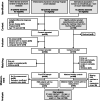Increased augmentation index in patients with Ehlers-Danlos syndrome
- PMID: 32933483
- PMCID: PMC7493396
- DOI: 10.1186/s12872-020-01684-x
Increased augmentation index in patients with Ehlers-Danlos syndrome
Abstract
Background: Ehlers-Danlos Syndrome (EDS) comprises a heterogeneous group of diseases characterized by joint hypermobility, connective tissue friability, and vascular fragility. Reliable prognostic factors predicting vascular disease progression (e.g. arterial aneurysms, dissections, and ruptures) in EDS patients are still missing. Recently, applanation tonometry derived augmentation index (AIx), an indirect marker of arterial stiffness, has shown to be positively associated with progression of aortic disease in Marfan syndrome. In this study, we assessed aortic AIx in patients with EDS and matched healthy controls.
Methods: We performed noninvasive applanation tonometry in 61 adults with EDS (43 women and 18 men aged 39.3 ± 14.6 years) and 61 age-, gender-, height-, and weight-matched healthy controls. Radial artery pulse waveforms were recorded and analyzed using the SphygmoCor System (AtCor Medical, Sydney, NSW, Australia). Calculated AIx was adjusted to a heart rate of 75/min. Groups were compared and association between AIx and EDS was determined by univariate and multivariate regression analysis.
Results: EDS patients were categorized in classical type EDS (34%), hypermobile type EDS (43%), vascular type EDS (5%), or remained unassignable (18%) due to overlapping features. EDS patients showed a significantly increased aortic AIx compared to healthy controls (22.8% ± 10.1 vs 14.8% ± 14.0, p < 0.001). EDS showed a positive association with AIx; independent of age, sex, height, blood pressure, medication, and pack years of smoking.
Conclusions: Patients with EDS showed elevated AIx, indicating increased arterial stiffness when compared to healthy controls. Further investigations are needed in order to assess the prognostic value of increased AIx for cardiovascular outcomes in patients with EDS.
Keywords: Arterial stiffness; Augmentation index; Cardiovascular risk; Ehlers-Danlos syndrome.
Conflict of interest statement
None.
Figures


Similar articles
-
Association between arterial stiffness and peripheral artery disease as measured by radial artery tonometry.J Vasc Surg. 2017 Nov;66(5):1518-1526. doi: 10.1016/j.jvs.2017.06.068. Epub 2017 Jul 26. J Vasc Surg. 2017. PMID: 28756044 Free PMC article.
-
Generalized Hyperalgesia in Children and Adults Diagnosed With Hypermobility Syndrome and Ehlers-Danlos Syndrome Hypermobility Type: A Discriminative Analysis.Arthritis Care Res (Hoboken). 2017 Mar;69(3):421-429. doi: 10.1002/acr.22998. Arthritis Care Res (Hoboken). 2017. PMID: 27483212
-
Arterial Elasticity in Ehlers-Danlos Syndromes.Genes (Basel). 2020 Jan 4;11(1):55. doi: 10.3390/genes11010055. Genes (Basel). 2020. PMID: 31947929 Free PMC article. Clinical Trial.
-
Differential diagnosis and diagnostic flow chart of joint hypermobility syndrome/ehlers-danlos syndrome hypermobility type compared to other heritable connective tissue disorders.Am J Med Genet C Semin Med Genet. 2015 Mar;169C(1):6-22. doi: 10.1002/ajmg.c.31429. Am J Med Genet C Semin Med Genet. 2015. PMID: 25821090 Review.
-
Vascular aspects of the Ehlers-Danlos Syndromes.Matrix Biol. 2018 Oct;71-72:380-395. doi: 10.1016/j.matbio.2018.04.013. Epub 2018 Apr 27. Matrix Biol. 2018. PMID: 29709596 Review.
Cited by
-
Modelling of the dilated sagittal sinuses found in multiple sclerosis suggests increased wall stiffness may be a contributing factor.Sci Rep. 2022 Oct 20;12(1):17575. doi: 10.1038/s41598-022-21810-3. Sci Rep. 2022. PMID: 36266424 Free PMC article.
-
Patient-derived extracellular matrix demonstrates role of COL3A1 in blood vessel mechanics.Acta Biomater. 2023 Aug;166:346-359. doi: 10.1016/j.actbio.2023.05.015. Epub 2023 May 13. Acta Biomater. 2023. PMID: 37187299 Free PMC article.
References
-
- Genetic Home Reference, https://ghr.nlm.nih.gov/condition/ehlers-danlos-syndrome#statistics, accessed on 04 August 2020.
-
- Malfait F, Francomano C, Byers P, Belmont J, Berglund B, Black J, et al. The 2017 international classification of the Ehlers-Danlos syndromes. Am J Med Genet C: Semin Med Genet. 2017;175(1):8–26. - PubMed
-
- Malfait F. Vascular aspects of the Ehlers-Danlos Syndromes. Matrix Biol. 2018;71–72:380–395. - PubMed
-
- Pepin MG, Schwarze U, Rice KM, Liu M, Leistritz D, Byers PH. Survival is affected by mutation type and molecular mechanism in vascular Ehlers-Danlos syndrome (EDS type IV) Gene Med. 2014;16(12):881–888. - PubMed
Publication types
MeSH terms
Grants and funding
LinkOut - more resources
Full Text Sources
Medical

